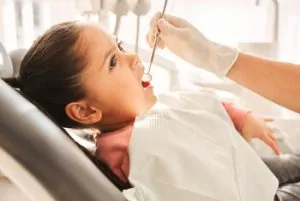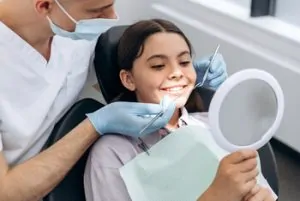As a parent, it’s both exciting and nerve-wracking to watch your baby’s first teeth emerge. You may find yourself staring at your baby’s gums, trying to figure out whether that little lump is a normal part of development or a sign that teething is finally on its way. Distinguishing between normal baby gums vs teething gums can help you respond appropriately to your child’s needs and bring them some much-needed comfort during this important milestone.
This article explores what healthy baby gums should look like, how they change when teething begins, and how you can gently ease your child’s discomfort.
Curious About Your Baby’s Gums? Here’s What Healthy Gums Should Look Like
In the first few months of life, before any teeth come in, your baby’s gums are smooth, pink, and soft to the touch. These healthy gums serve as the base for future baby teeth, also known as milk teeth. There’s usually no swelling, and they don’t feel warm or bumpy.
Your baby’s gums at this stage are:
- Uniform in colour
- Free from redness or inflammation
- Flat and cushiony, with no raised bumps
- Not tender to the touch
A few babies are actually born with teeth already visible, known as natal teeth, although this is quite uncommon. In most cases, the gums remain unchanged until around four to seven months of age, when the first signs of teething begin to show.
What’s Changing in There? Early Signs Your Baby’s Gums Are Teething
Teething gums look and feel quite different. The changes often begin a few weeks before the first tooth appears. This process is triggered by erupting teeth pushing through the gum line, which can make your baby’s gums swollen, sensitive, and sometimes a bit red.
Common changes you may notice include:
- Swollen or inflamed gums
- A visible white bump under the gum, often a hard tooth growing underneath
- Increased drooling and chewing
- Rubbing their baby’s mouth or pulling at the baby’s chin
- Fussiness or irritability, especially at night
These are some of the early teething symptoms that help distinguish teething gums from normal ones.
Which Tooth Pops Up First? A Parent’s Guide to the Teething Timeline
Most babies follow a general pattern for baby teeth eruption, although the exact timing can vary from child to child.
Here’s a common sequence of how the first teeth emerge:
- Lower central incisors (bottom front teeth): around 6 to 10 months
- Upper central incisors (top front teeth): around 8 to 12 months
- Upper lateral incisors (next to the top front teeth): around 9 to 13 months
- Lower lateral incisors: around 10 to 16 months
You’ll usually notice changes in the baby’s gums on the same side before two teeth come through closely together. As more new teeth erupt, teething continues in phases until all 20 milk teeth have appeared by around age 3.
Is It Teething or Something Else? How to Decode Your Baby’s Behaviour
While a teething baby may show physical signs like sore gums or a slight bump, there are also behavioural clues:
- Constantly chewing on objects, fingers, or their baby’s lip
- Trouble sleeping or waking more frequently
- Refusing to feed due to sensitive gums
- Mild temperature increase (though not usually a fever)
It’s worth noting that many teething symptoms overlap with other common baby issues like illness or growth spurts. Always consult your dentist if your teething child shows signs of high fever, severe discomfort, or unusual changes in behaviour.
Teething Blister or Something Else? What That Dark Spot on Your Baby’s Gum Really Means
A teething blister or eruption cyst may appear on your baby’s gums as a bluish or purple bump just before a tooth appears. It’s generally harmless and goes away once the erupting tooth breaks through.
These cysts are filled with fluid and should not be popped or pressed. If you’re unsure, have your dentist check it during a routine visit.
How to Soothe Your Baby’s Teething Gums
When it comes to easing a child’s discomfort, you have a few safe, soothing options:
Use a Teething Toy or Teething Ring
These are designed to be chewed and massaged with the gums. Choose a safe, BPA-free teething ring that can be cooled in the fridge to provide extra comfort. Avoid freezing, as this can be too hard and potentially hurt your baby’s mouth.
Gently Rub Their Gums
Use a clean finger or a damp washcloth to gently massage the affected area. This can help relieve pressure from erupting teeth and reduce inflammation.
Offer a Sugar-Free Rusk or Hard Foods
If your teething baby has started eating solids, hard foods like chilled cucumber sticks or sugar-free rusks can be a satisfying way to chew safely. Always supervise to avoid choking hazards.
Keep Their Mouth Clean
Even before baby teeth start coming through, it’s a good idea to gently wipe your baby’s gums using a clean finger or soft cloth after feeding. Once teeth appear, use a baby toothbrush with a pea-sized amount of fluoride toothpaste.
Teething Gels
Some parents turn to teething gels or pain relief options, but it’s essential to speak with your healthcare provider before using these. Not all teething gels are safe for babies under a certain age.
Teething and Tiny Teeth: How to Keep That First Smile Healthy from the Start

Tips to encourage healthy oral hygiene include:
- Start brushing with a soft baby toothbrush as soon as the first tooth comes in
- Avoid letting your baby sleep with a bottle in their mouth
- Don’t dip pacifiers in sweet substances
- Clean between child’s teeth as more teeth emerge, using dental floss when necessary
Still No Teeth? Here’s What to Know About Delayed Teething
It’s normal for some babies to begin teething a little later than others. If your baby has no signs of teething by 12 months of age, it’s a good idea to mention it during their check-up. In most cases, baby teeth will appear in their own time, especially if there’s a family history of delayed teething.
When to See a Dentist
Your baby’s first dental visit should happen by the time they turn one or within six months of their first tooth coming through. The dentist will check your baby’s gums, alignment, and overall oral health and offer personalised advice on teething and cleaning routines.
Frequently Asked Questions
When do baby teeth start to come in?
Usually, between 4 and 7 months of age, starting with the lower central incisors.
Are teething gels safe for babies?
Some are but always check with your doctor before using any medicated teething products.
What helps with teething pain?
Cool teething rings, gentle gum massages, sugar-free rusks, and extra cuddles often help soothe your baby.
Is it normal for teething to cause a mild fever?
Slight temperature increases can happen, but a true fever is not considered a normal part of teething. Contact your dentist if you’re concerned.
Can I brush my baby’s teeth before they fully come in?
Yes. You can gently wipe their baby gums and brush new teeth with a baby toothbrush and a pea-sized amount of toothpaste once they erupt.
Let teething be less stressful for you and your baby by staying calm, patient, and well-prepared.
Final Thoughts: Learning to Spot the Difference

By staying informed and using gentle, practical methods to ease discomfort, you can help your baby feel calmer and more comfortable as their first teeth make their debut. And remember, if you’re ever unsure about a change in your baby’s gums or their symptoms, a quick visit to Good Choice Dental can offer peace of mind and guidance. Book your consultation today at (02) 8203 8760.
References
Frothingham, S. (2018, December 5). Deciduous teeth. Healthline. Medically reviewed by C. Frank, D.D.S. Retrieved from https://www.healthline.com/health/deciduous-teeth
Ou, X., Zhang, Y., Li, Z., Chen, X., … & Wang, Y. (2022). Eruption timing and sequence of primary teeth in a sample of Romanian children. Diagnostics, 12(3), 606. Retrieved from https://pmc.ncbi.nlm.nih.gov/articles/PMC8947037/
U.S. Food and Drug Administration. (n.d.). Safely soothing teething pain in infants and children. Retrieved from https://www.fda.gov/consumers/consumer-updates/safely-soothing-teething-pain-infants-and-children






Recent Comments